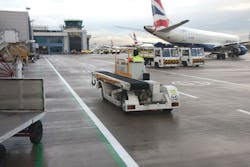A Brief History Of Line Operations Safety Audits
Tax season is upon us and for some folks and organizations the word “audit” inherently has a negative connotation attached to it.
In the aviation industry, the term has a better meaning. Line Operations Safety Audits or LOSA is a safety management program that is available to help identify risks within airlines operations. Human Factors is a big part of the LOSA program, specifically, principals for Threat and Error Management or TEM.
Over the last 23 years, LOSA has developed from a program that was initially constructed for analysis of behaviors in the flight deck into an operational strategy for real-time data analysis of normal operations that supports data-driven organizational change based on employee threat and error management at the maintenance and ramp operations level.
The original research development of the maintenance and ramp LOSA forms and procedures was under the direction of the former Air Transport Association or ATA, which is now known as Airlines 4 America or A4A). The organization’s Human Factors Task Force with funding primarily supported through the FAA. The task force consulted numerous airline safety representatives who participated in the development and implementation of the current maintenance and ramp line operations safety auditing efforts.
LOSA BASICS
LOSA is comprised of several characteristics that include peer-to-peer observations during normal operations by trusted and trained observers using observation techniques based on TEM.
Joint management/union sponsorship will need to be coordinated to ensure success. The data collection process is non-punitive; observations will be anonymous and confidential with observational data being housed in a secure data collection warehouse.
Once data has been collected, organizations will need to verify the data with the LOSA team and operational leadership which should result in data-derived targets for improvement. Most importantly, feedback from the LOSA observations will need to be communicated back out to the workforce.
The purpose of a Safety Management System is to provide a systematic way to control risk and to provide assurance that those risk controls are effective. An SMS will also identify risk and ensure that it is designed out or reduced to an acceptable level for new programs before implementation.
Air carriers and airports across the United States have been addressing the FAA’s proposed 14 CFR Part 5. The SMS NPRM also includes the draft revision to AC 120-92 and the new draft SMS chapter for FAA Order 8900.1. The FAA’s proposed SMS rule and guidance materials are modeled after the ICAO’s SMS Framework.
Safety risk management (SRM) requires development of processes and procedures to provide an understanding of the carrier’s operational systems to allow operational employees identify hazards associated with those systems. Once hazards are identified, other procedures must be developed under SRM to analyze and assess the risk resulting from these hazards, as well as to institute controls to reduce or eliminate the risks from these hazards.
Most safety programs are developed to be used as a response mechanism to events (incidents and accidents) that have already occurred in the operation. LOSA can help actively identify hazards through the analysis of the organizations processes. A healthy LOSA program will also assist with proactive analysis that closely looks at system processes and environment to identify any potential problems that may occur in the future.
Ground and maintenance LOSA programs have evolved from early Crew Resource Management (CRM) principals that were used during flight deck LOSA development to analysis that focused on human error and Threat and Error Management, which is the currently the main principal behind ground LOSA programs.
One of the main objectives behind line operations safety audits is to identify employee behaviors that lead to effective and ineffective threat and error management. Many “red flags” or “threats” that occur in the operation at any given time most often times do not lead to an accident or incident; LOSA helps organizations understand employee response to these “red flags” or “threats” that have not led to negative consequences such as aircraft damage or employee injuries.
TEM understands that threats, such as unfavorable weather, errors, such as speeding on the ramp, while driving GSE, and undesired states, such as a late arriving aircraft, are everyday events that employees working in an airport environment must manage to maintain the safety of equipment, other employees and themselves.
RISK FACTORS
If we take a look into risk factors that are present in the everyday airport operating environments, threats are considered normal or abnormal, which could lead an employee into a situation that can cause an employee to commit a potential error or result in a bad outcome.
Error management takes actions against those errors that have been committed by identifying them and putting a corrective action plan in place to eliminate them, or containing the errors and reducing the severity of the error outcome. Error management is often considered managing the past where is threat management is considered managing the future.
Errors occur when a mistake has been mismanaged; managing errors requires recognition and correction before these errors have a negative consequence to safety.
Some types of errors are intentional, non-compliance errors, but also procedural errors, and errors that occur during miscommunication. Proficiency errors and operational decision errors can be inconsequential to safety, but can also lead to an undesirable state if it is not addressed correctly or ignored. This may also lead to additional errors and may make situations worse.
LOSA is a tool that can be used in the operation to help identify threats, errors and undesired states and can assist in building strategies and mitigation plans to reduce risks in the airport environment. LOSA helps front line employees become better threat managers by actively identifying threats in the operation and helps build a safety culture by encouraging open and honest communications.
About the author: Kevin P. Crowley, senior analyst for ground safety programs, CQA/ASQ, JetBlue Airways Corp., started on the ramp in Buffalo, NY, in 1993. He's been with JetBlue for 12 years and began as an instructor at JetBlue University and taught aircraft servicing for the A320 and E190. He has additional experience in HAZMAT and dangerous goods; winter ops and deicing; and is a certified OHSA instructor.
The ABCs Of LOSA
By Dr. William Johnson
Line Operations Safety Assessments (LOSA) require employee involvement to identify safety threats to areas of ramp operations. For most airline and airline-related service organizations, a Safety Management System (SMS) can be a formalization of the many safety programs already in place.
LOSA is a way for employees to observe one another’s work. Although it is peer-to-peer observation, it is a formal process.
LOSA is not new. Since the late 1990s, LOSA has evolved in flight operations and is widely used today.
Line pilots, for example, trained to be LOSA observers, fly jump seat and observe the crew. The observer looks for excellent performance, but also observes whether threats and errors are present. The observer is trained not to interfere with normal operations unless there is grave danger to people or property.
Those being observed know that the LOSA is not a classic “audit” and that LOSA data cannot attribute actions to an individual or crew. LOSA is a formal employee system that does real-time risk assessment using the threat and error management model.
RAMP AUDITS
The LOSA system for ramp is very different from that used on the flight deck. The philosophy and principles are the same, but the flight deck relies on open-ended text to record the observations.
The ramp LOSA, on the other hand, uses structured observation checklists. The system for ramp comes complete with ready-to-use database and data analysis tools that are kept with the operator. There is no need for outside data storage and analysis. This ensures that company data are secure and that analysis does not require external consultants.
The accompanying illustration shows the characteristics of the LOSA systems used for maintenance and for ramp environments. It is a systematic means for observation of normal operations. The peer-trusted observers, as well as those observed, participate in LOSA as volunteers.
LOSA is a joint effort by company management and labor to recognize early indications of threats and errors. Sometimes LOSA can be targeted to assess known challenges. In any case, the standards for confidentially always apply.
SMS Data Types
SMS regulations encourage us to take our data collection to the next level.
Here's what we mean:
- When looking at reactive data, the event has already occurred and the damage done. Companies usually have accident/event procedures in place and are prepared to launch an investigation team and establish fact-based contributing factors. Afterward, the FAA and any number of industry organizations and publications help disseminate accident/event data. This helps reduce the chance that the event may be repeated by another company.
- Collecting, analyzing, and applying proactive data isn't new, only the emphasis on the term is new. Aviation organizations have auditing, quality, and safety departments that apply a multitude of operational measures to assess current performance and safety.
- Predictive data systems are a means to use daily/normal operations to help identify a company’s strengths and weaknesses.
Sometimes there is confusion between the terms used in “system safety” versus the language used in “threat and error management.”
Using the language of system safety, predictive data helps identify the small hazards in advance of assigning a risk level. Using the language of threat and error management, predictive data helps identify the threats so that they can be managed before they become errors. In any language, however, it is a matter of identifying and addressing challenges as early as possible.
How can you establish systems to gather and apply predictive data? Most likely, frontline employees see the hazards before management does. Predictive data, therefore, must be worker-centered. Companies must make it easy for employees to speak up. Voluntary reporting systems are likely the best means to achieve this goal.
FAA cooperates with the industry through programs such as the Aviation Safety Action Program (ASAP). It protects workers from FAA action when they report mistakes early. Progressive companies use ASAP as a means to report not only events but also to report the conditions (threats) that may lead to events.
EDITOR'S NOTE: This is an edited version of an article, "SMS Jargon And Collecting Predictive Data," that originally was published in the February/March 2012 issue of Airport Business.
About the author: Dr. William Johnson is the FAA Chief Scientific and Technical Advisor for Human Factors in Aircraft Maintenance Systems. Johnson is a member of the Human Factors Advisory Group to the European Aviation Safety Agency (EASA).
About the Author

Kevin Crowley
About the author: Kevin P. Crowley, senior analyst for ground safety programs, CQA/ASQ, JetBlue Airways Corp., started on the ramp in Buffalo, NY, in 1993. He's been with JetBlue for 12 years and began as an instructor at JetBlue University and taught aircraft servicing for the A320 and E190. He has additional experience in HAZMAT and dangerous goods; winter ops and deicing; and is a certified OHSA instructor.
